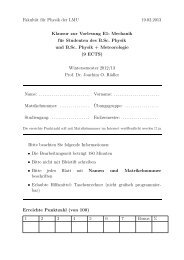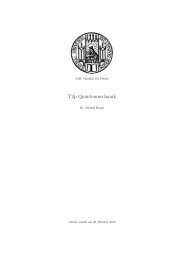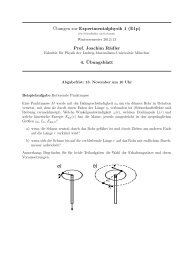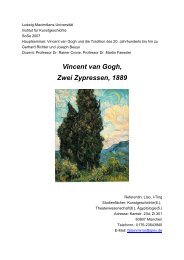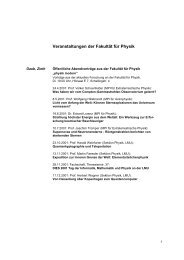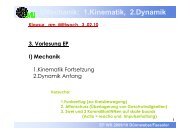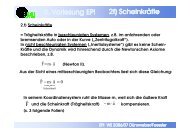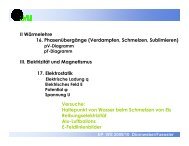Magnetic-Field-Induced Spin-Conserving and Spin-Flip ...
Magnetic-Field-Induced Spin-Conserving and Spin-Flip ...
Magnetic-Field-Induced Spin-Conserving and Spin-Flip ...
You also want an ePaper? Increase the reach of your titles
YUMPU automatically turns print PDFs into web optimized ePapers that Google loves.
VOLUME 74, NUMBER 14 PHYSICAL REVIEW LETTERS 3APRIL 1995<br />
could ratio the spectra against those of a reference<br />
substrate.<br />
In Fig. 1 we show a transmission spectrum of our<br />
sample taken under an oblique angle of 57 ± used in<br />
a ratio against a reference substrate (upper trace). In<br />
this conventional IST configuration the refraction of the<br />
incident light results in a finite electric field component<br />
perpendicular to the 2DEG as required to excite an IST<br />
at B 0 T. The extracted resonance position agrees<br />
quite well with the one theoretically expected. Also<br />
the oscillator strength is found to exhibit the calculated<br />
dependence on the tilt angle (not shown in the figure).<br />
In the Voigt configuration, i.e., the light incident perpendicular<br />
to the sample plane <strong>and</strong> the in-plane magnetic<br />
field, we obtain the lower traces of Fig. 1. The spectra<br />
have been taken between B 2 T <strong>and</strong> B 13 T with a<br />
reference at B 0. Surprisingly, we observe two well<br />
separated resonances—one at around E 100 meV A<br />
<strong>and</strong> a second at E 135 meV C. In an additional experiment<br />
which is not shown here we verified that for the<br />
in-plane light polarization no absorption is detectable at<br />
zero magnetic field. Hence, we conclude that both resonances<br />
A <strong>and</strong> C are induced by the magnetic field <strong>and</strong> gain<br />
strength at high fields. With increasing field, the position<br />
of line A shifts to higher energies from E 94 meV at<br />
B 2 TtoE109 meV at B 13 T, whereas the position<br />
of the much narrower line C remains almost constant.<br />
Furthermore, line C is symmetric, <strong>and</strong> its width does not<br />
depend on the magnetic field. Its integrated absorption,<br />
however, increases quadratically with the field (inset of<br />
Fig. 1). Comparing with the top trace, resonance C is<br />
readily identified as the depolarization shifted IST. This<br />
conclusion is based on the fact that the energetic position<br />
<strong>and</strong> line shape are almost identical in both spectra. The<br />
low-energy resonance A, on the other h<strong>and</strong>, gains oscillator<br />
strength by an increase of both the absorption depth<br />
<strong>and</strong> the linewidth. It is considerably broader than line C<br />
at all fields <strong>and</strong> also becomes more <strong>and</strong> more asymmetric<br />
as the magnetic field is increased.<br />
To underst<strong>and</strong> the spectra in more detail we calculate<br />
the single particle subb<strong>and</strong> energies within the framework<br />
of a three-level k p model [13] as a function of the<br />
parallel magnetic field, where bending of the quantum<br />
well bottom has been taken into account by first order<br />
perturbation theory. Throughout this Letter we choose the<br />
direction of growth <strong>and</strong> the electric confinement to be y<br />
while the magnetic field is applied in the z direction B k z.<br />
In Fig. 2 we plot the intersubb<strong>and</strong> transition energies<br />
DE for k x k z 0 <strong>and</strong> in the inset a schematic of<br />
FIG. 1. The upper trace shows a transmission spectrum of<br />
our InAs/AlSb multiple quantum well used in a ratio against<br />
a reference substrate with the radiation incident under an<br />
oblique angle of 57 ± . The strength of the resonance follows<br />
the same polarization dependence as expected for intersubb<strong>and</strong><br />
transitions. We are not yet certain how to interpret the small<br />
structures around E 90 meV as they may be caused by the<br />
ratio. In the magnetic field ratio of the same sample we show<br />
spectra TB fi 0TB 0 at in-plane magnetic fields B 2,<br />
4, 6, 8, 10, 11, 12, <strong>and</strong> 13 T. Both resonances A <strong>and</strong> C vanish<br />
at zero magnetic field, <strong>and</strong> their absorption increases at higher<br />
fields. The inset shows that the integrated absorption of line C<br />
depends quadratically on the magnetic field.<br />
FIG. 2. Single particle transition energies between the HMES<br />
for k x k z 0. The spin-conserving transitions differ only<br />
very little in energy while the spin-flip excitations are energetically<br />
more separated. As the b<strong>and</strong> parameters were<br />
take E g 0.42 eV, D 0.38 eV, <strong>and</strong> the Kane energy E p <br />
22.9 eV. The inset shows schematically the relevant subb<strong>and</strong><br />
edges as a function of the magnetic field. The spin-up branch<br />
is lower in energy than the spin-down branch because the electronic<br />
g factor of InAs is negative.<br />
2773




